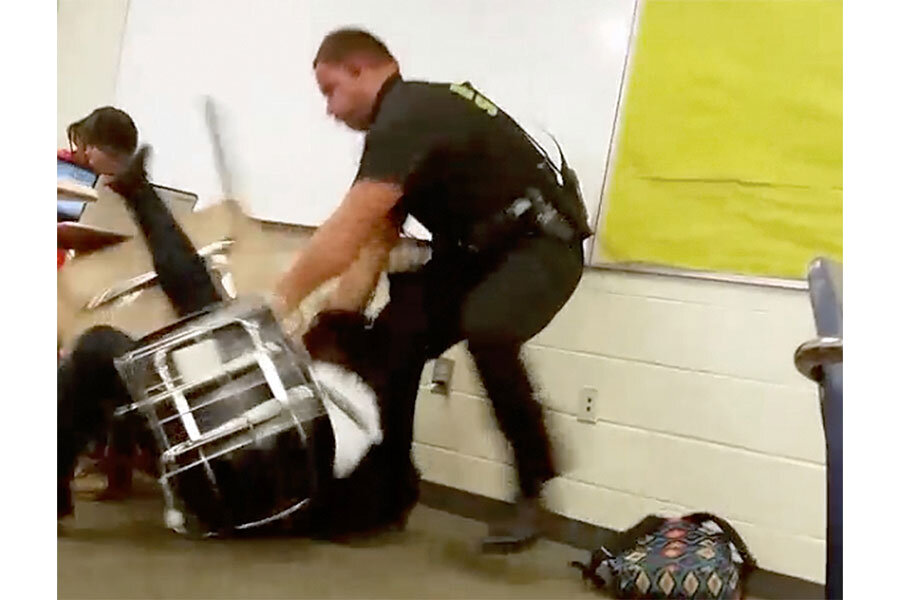Baltimore video sheds new light on police violence in schools
Loading...
Just as videos of a series of police incidents across the country have increased public scrutiny of street cops, videos taken in classrooms have begun to put a new spotlight on police officers in schools.
Criminal charges were brought against two Baltimore school police officers on Tuesday after a video surfaced on social media showing one of the officers kicking and slapping a student. Meanwhile, in South Carolina, the Federal Bureau of Investigation and the United States Department of Justice are investigating a sheriff's deputy who was recorded slamming a student to the ground and throwing her across a classroom last October.
The cases are set to explore whether school police officers have the same broad legal protections afforded to other police. Many legal experts suggest they do.
But the bigger issue could be how the incidents portray police in schools, known as school resource officers (SROs). Polls show that videos of police encounters on the street have had an impact on how the public views police. That could be even truer about cops in schools.
"A primary purpose of SROs is to improve community relations with police. This is a function where optics do really matter," says Emily Owens, an associate professor of criminology at the University of Pennsylvania, who has researched SRO programs.
When it comes to SROs and criminal charges, she adds, "the court of public opinion is as, if not more, important than the actual court."
The main goals of SRO programs are to protect students, counsel students, and give students "a positive image of law enforcement," according to the National Association of School Resource Officers' website.
Bolstered by federal funding and public fear of violent crime and school shootings, SROs have expanded dramatically. In 1975, 1 percent of US schools had assigned police officers. By 2007, 40 percent did. In 2013, there were 15,000 SROs nationwide.
But as the number of SROs rises, so has the number of cellphone cameras. Cellphone recordings have been at the center of some of the more recent SRO controversies – from the incidents in Baltimore and South Carolina to the handcuffing of a third-grader in Kentucky that has triggered a lawsuit.
For that reason, these cases are likely to become increasingly common, says Jason Nance, an associate professor at the University of Florida Levin College of Law.
"This is a relatively new thing because we haven't had that [video] documentation before; we've only had anecdotal evidence," he says. "If it's the police officer's word versus the student's word, people are less likely to file a criminal action against an officer."
Legal experts say they expect SROs to receive much the same legal deference that ordinary police officers do.
"I don't think it would be fundamentally different," says Kami Chavis Simmons, a former US attorney who now directs the criminal justice program at the Wake Forest University School of Law.
"Officers are allowed to use force to do their job, but they can't use that force unreasonably,” she adds. "If they use that force unreasonably, they may be subject to civil lawsuits as well as criminal lawsuits."
And if cases do go to court, SROs, like most police officers, could benefit from sympathetic juries.
"Everyone recognizes that policing is violent," says Philip Stinson, an associate professor of criminology at Bowling Green State University in Ohio. "If there's any rational way to explain that the [officer's] behavior is reasonable, in the jury's mind that's going to make it difficult to convict them."
It is still exceedingly rare for criminal charges to be brought against a school police officer, data show. A 2014 study by Professor Stinson found that 52 school police officers were arrested for criminal offenses between 2005 and 2011. Most of the arrests were for "sex-related offenses" involving female students, says Stinson, who has been tracking arrests and prosecutions of police officers for more than a decade.
But he is concerned that cellphone videos might be bringing to the surface a bigger problem.
"Most police officers serve honorably, so all the cases in my database and research are outliers in some respects," he says. "I hope that's the case here – that we’re not seeing something that’s common behavior that we don’t know about."








